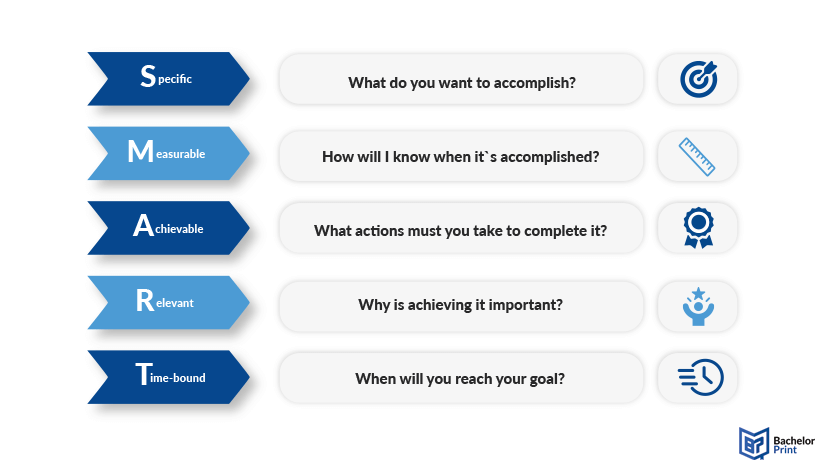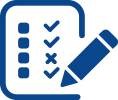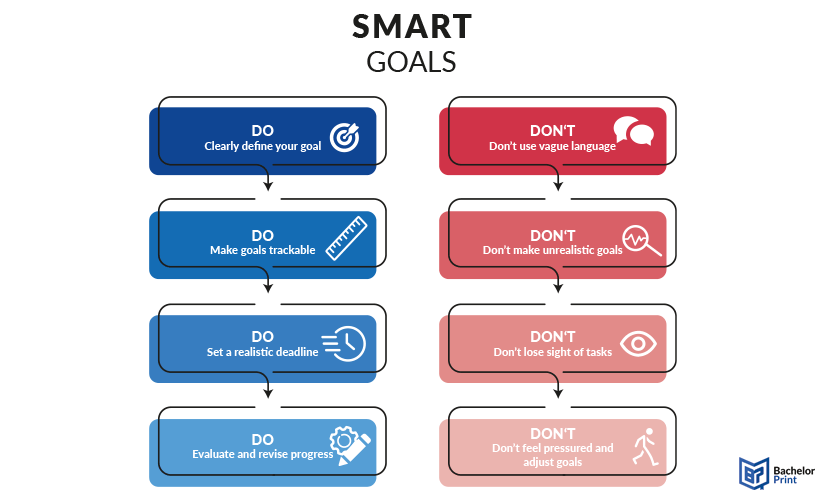
The SMART goals methodology serves as a structured approach to defining and achieving objectives. This framework is widely used in business, education, personal development, and project management, to ensure that goals are set and have a clear path to success. In this article, we delve into the principles of SMART goals and explore how they can revolutionize the way you pursue your aspirations.
Definition: SMART goals
SMART goals are a set of guidelines for setting objectives that are Specific, Measurable, Achievable, Relevant, and Time-bound. This SMART goal framework is widely used in business, education, personal development, and project management to ensure that individual or team goals are well-defined and have a clear path to success. By following the SMART framework, individuals, and organizations can set clear and achievable goals, which will increase the likelihood of success.
The 5 steps
Let’s break down the SMART acronym, discuss each one in detail to understand the qualities of SMART goals, and include a practical example. Here we use the example of “I want to improve my math grades.”


Specific
As the first SMART goal step, we focus on the specifics of the goal, and the question of
- what do you want to accomplish?
When starting your aspiration journey, you initially need to be clear and precise in your wording, stating exactly what it is you aim to achieve.

Measurable
Step two of a SMART goal stands for measurability, and asks the question of
- how will I know when it’s accomplished?
Your goal should be easy to measure, which will help you track your progress and know when you have reached the finish line.

Achievable
The goals you set should be achievable, this step answers the question of
- what actions must you take to complete it?
It’s necessary to figure out the scope of attainability for the initial goal or objective you want to achieve. If it’s almost impossible, the failed results will only lead to stress and disappointment.

Relevant
When talking about the step of relevance, we need to pose the question of
- why is achieving it important?
This phase is essential when it comes to SMART goals. By having complete control over your current actions and efforts, it becomes easier to assess the progress of your goal, motivating and inspiring you to take action and staying on track to achieve the desired outcome.

Time-bound
The final step focuses on the designated time limit of your SMART goal and asks
- when will you reach it?
To properly measure success, you require a clear-set deadline to focus on and work toward. This will give you a sense of urgency and prevent deviating from your long-term goal.
After checking all of these boxes, a comprehensive goal-setting plan is created that ensures your focus and progress in the right direction to achieve your concrete goal. To help you write down your own ambitious goals, we’ve created a free and easy-to-use SMART goals template with all the tools needed to achieve your goal.
SMARTER goals
The term SMARTER expands upon the traditional SMART criteria to include additional elements, enhancing the goal-setting strategy by Evaluating and Revising your goals. Presented below is a table that incorporates previous information, as well as enhancing the SMART goal example presented in the preceding section.
| Specific | What do you want to accomplish? |
| Measurable | How will I know when it's accomplished? |
| Achievable | What actions must you take to complete it? |
| Relevant | Why is achieving it important? |
| Time-bound | When will you reach your goal? |
| Evaluate | What can you learn from current progress? |
| Revise | How can you adapt your strategies? |

Evaluate
The evaluate step imposes the question of
- what can you learn from current progress?
This question evaluates the current situation and gains insights from ongoing progress. It prompts reflection on the outcomes achieved so far, allowing individuals or teams to identify successes and areas for improvement. By evaluating current progress, one can gain valuable information to influence future decisions.

Revise
The final process of revising asks the question of
- how can you adapt your strategies?
This step emphasizes the need for flexibility in adjusting strategies to better align with evolving goals or circumstances. Challenges can always emerge when having a strategic goal, which is why keeping track of your progress is important so that you can stay productive and adapt to obstacles immediately.
Examples
Since we have already covered an example of a well-crafted SMART goal for students, in this section you’ll find numerous additional examples for particular fields.
- Specific: Increase monthly sales revenue by 20%.
- Measurable: Track sales figures weekly and compare against previous months.
- Achievable: Implement a new marketing campaign and offer discounts to promote purchases.
- Relevant: Increasing sales revenue aligns with the company’s shared goal of expanding market share.
- Time-bound: Achieve the sales target within the next six months.
Optional:
- Evaluate: Review sales performance monthly to assess progress towards the goal.
- Revise: Adjust marketing strategies or promotional activities based on evaluation results to optimize effectiveness and meet the sales target.
- Specific: Lose 10 pounds of body weight.
- Measurable: Weigh myself every week and track progress.
- Achievable: Follow a balanced diet plan and exercise regimen recommended by a fitness trainer.
- Relevant: Improving fitness and losing weight will enhance overall health and well-being.
- Time-bound: Reach the weight loss goal within three months.
Optional:
- Evaluate: Monitor weight loss progress weekly and adjust diet and exercise routines as necessary.
- Revise: Modify the workout routine or nutrition plan based on evaluation findings to ensure steady progress towards the weight loss goal.
- Specific: Read one personal development book per month.
- Measurable: Keep a log of books read and write a summary of key takeaways.
- Achievable: Set aside 30 minutes each day for reading and reflection.
- Relevant: It aligns with my long-term aspirations for career advancement and self-improvement.
- Time-bound: Complete the entire goal for the year by reading 12 books in 12 months.
Optional:
- Evaluate: Reflect on the insights gained from all books and assess how they relate to my growth.
- Revise: Adjust reading selections or allocate more time for reflection based on evaluation to maximize learning and development.
Advantages & disadvantages
There are numerous benefits and a few drawbacks when it comes to using this methodology. Below, we have evaluated the potential positive and negative outcomes of this strategy.
Advantages
- Provides clarity and direction.
- Evaluates strengths & weaknesses.
- Motivates through small milestones.
- Focus on measurable outcomes.
- Allows for ongoing adjustments.
Disadvantages
- Disappointing if not achieved.
- May add unnecessary pressure.
- Motivation may decrease.
- May cause addiction to success.
- Goal may cause neglect of other tasks.
Dos & donts
Having a SMART goal worksheet encourages well-planned actions; however, there are mistakes you can make during the progress of creating your own SMART or SMARTER goals. In this section, we focus on what to do and what not to do.

FAQs
S stands for Specific. M stands for Measurable. A stands for Achievable. R stands for Relevant. T stands for Time-bound. S means that you have to be clear and specific in what your personal goal is.
Specific: Improve my GPA from 3.0 to 3.5 by the end of the semester.
Measurable: Track my grades in all classes and calculate GPA at the end of each grading period.
Achievable: Attend all classes regularly, complete assignments on time, seek help from teachers or tutors when needed, and dedicate at least two hours per day to studying.
Relevant: Increasing my GPA will enhance my academic record and improve my chances for scholarships or admission to graduate school.
Time-bound: Achieve it by the end of the current semester, which gives me four months to work towards it.
Optional:
Evaluate: Review my grades and GPA monthly to assess progress towards the goal.
Revise: Adjust study strategies or seek additional support based on evaluation findings to stay on track towards achieving the GPA target.
The SMART goals acronym means Specific, Measurable, Achievable, Relevant and Time-bound.
Setting vague goals that are not specific, measurable, achievable, relevant, and time-bound is a recipe for failure. By merely stating your desire, “I want to become a Doctor”, it remains as just that, a desire. The statement has no sense of direction and lacks clarity. Setting SMART goals will push you in the right direction, increase your chances for success, and help you create a roadmap to aid you in actually achieving those goals.
SMART goals provide a structured approach to goal-setting that promotes focus, responsibility, and progress tracking, ultimately leading to greater success in achieving desired outcomes.
